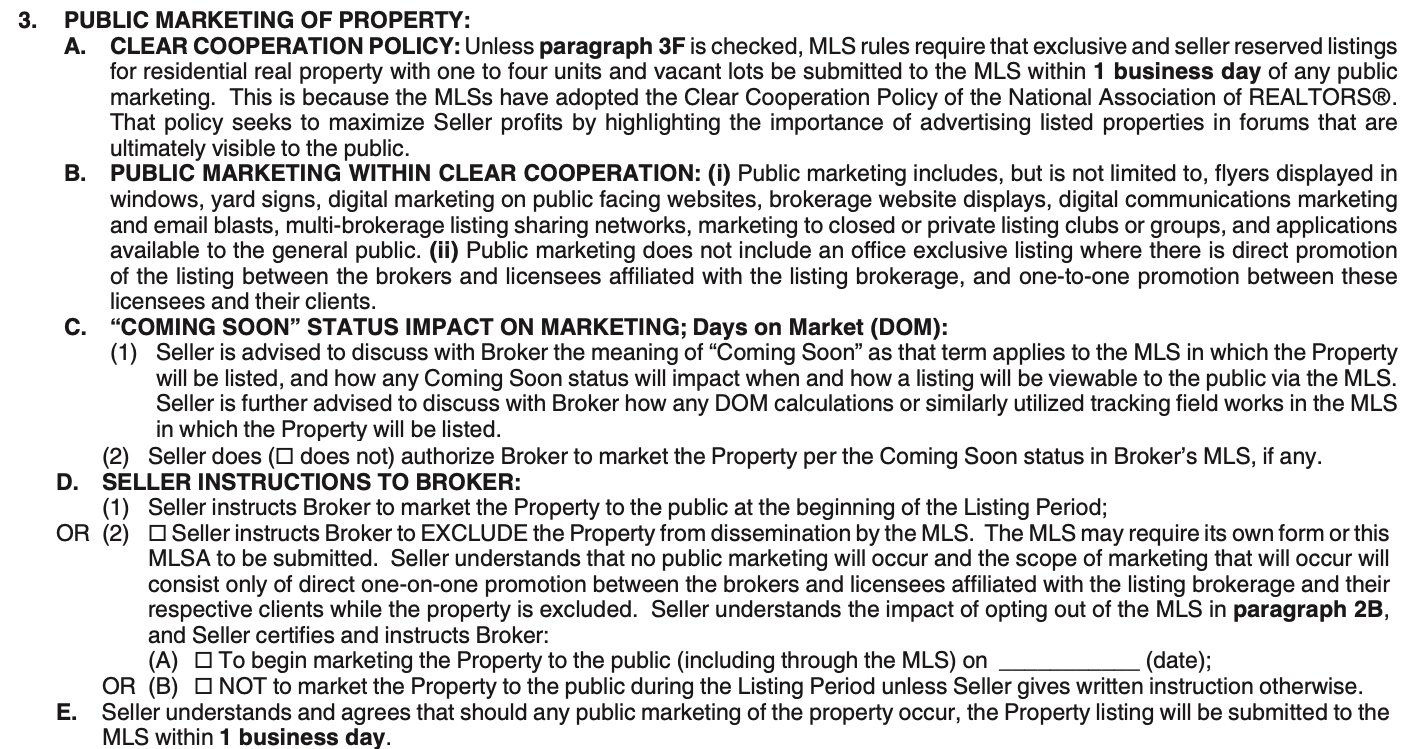In today’s competitive real estate landscape—especially in markets like Silicon Valley and the Bay Area—sellers increasingly crave control, privacy, and the chance to test their home’s appeal before diving into a full-blown listing. Compass’s enhanced Three‑Phased Marketing Strategy delivers exactly that, and their newly created disclosure form (introduced May 28, 2025) shines a light on how each step works, what sellers can gain, and what trade‑offs they should consider. You can download a sample copy of the disclosure here.
The Three-Phase Strategy: Flexibility with Purpose
Compass’s approach breaks the traditional real estate launch into three distinct, optional phases, all tailored to suit a seller’s unique needs:
-
Compass Private Exclusive kicks off the marketing quietly within Compass’s network. Agents share the property privately with qualified buyers, offering early insights without triggering public listing activity or accruing days on market (DOM).
-
Compass Coming Soon follows—here the listing goes live on Compass.com and may circulate via email or digital ads, but still avoids a public MLS listing. This builds anticipation while still holding off on public exposure to DOM or historical price drops. However, while the property will not be publicly listed on the MLS, I will list the home as a Coming Soon on our local MLS system, which means that any agent with access to our local MLS will be able to see the listing and share it with their buyers.
-
Full MLS Launch unleashes the listing across the broader market—MLS, Zillow, Redfin, Realtor.com—and attracts the widest set of buyers.
By allowing sellers to “test the waters” in controlled increments, Compass empowers them to mitigate risks like DOM stigma or price drop history, while refining pricing and preparation before going public.
What the Updated Disclosure Form Says
Compass’s Three Phased Marketing Disclosure Form creates transparency and seller choice. It now explicitly:
-
Clarifies that Phases 1 and 2 are not public listings and won’t appear publicly on MLS or major portals.
-
Emphasizes that sellers are never required to accept offers in the off‑MLS phases.
-
Outlines key benefits—from enhanced privacy to market-price testing—while also addressing potential limitations, such as reduced buyer exposure and the chance of not maximizing offers.
-
Reinforces Fair Housing compliance and encourages sellers to choose responsibly.
This open, detailed approach ensures sellers make informed decisions tailored to their circumstances—whether they value privacy, speed, or maximizing price.
Data‑Driven Benefits: More Money, Less Time
Compass supports its three‑phase strategy with compelling performance data from 2024: homes that underwent pre‑marketing saw an average 2.9% higher sale price, went under contract roughly 20% faster once listed publicly on the MLS, and were 30% less likely to require a price reduction.
To put that in perspective: for a typical $1 million home, that’s a $29,000 boost in closing price—a meaningful gain in a single transaction .
This isn’t just a theory. Compass CEO Robert Reffkin explained that the newly enhanced disclosure is part of a broader effort to “promote greater transparency and professionalism” while “ensuring every one of our clients has a clear understanding” of how the phased strategy works .
Diving Into Each Phase: Strategies, Risks, and Returns
Phase 1: Compass Private Exclusive
In this “quiet launch,” listings circulate only among Compass agents and their clients. Sellers gain exclusive early visibility, sidestep public stigmas of opacity, and test aspirational pricing with a controlled audience. There’s even potential to receive offers before full public exposure—a win for both speed and discretion.
The trade-off? Buyers outside the Compass network won’t see the listing, possibly shrinking the buyer pool. But for those who prioritize privacy or want to preserve DOM, this can be a savvy move.
My advice is to think of Phase 1 simply as a way to quietly announce that the listing is coming to the market to the highest-performing network of agents in the Bay Area, as a way to gauge interest in the property and pricing. Within a week or two of the property being a Compass Private Exclusive, we’ll have an idea of what buyer interest will be like, given the list price. It may be that buyer interest is high, to the point an offer is made. But if an offer is made, be aware that there may be another buyer out there who would offer more, or offer better terms.
Phase 2: Compass Coming Soon
Next, the property is featured on Compass.com, and listed as a “coming soon” on the local MLS system (available to agents, but not visible to the general public, unless an agent shares the listing with someone). In this stage, the listing may be promoted through targeted marketing like email campaigns, direct mail or digital ads—still without triggering DOM or a price‑drop record. Sellers gain visibility, buzz, and valuable engagement metrics (views, shares, saves) to refine pricing and staging before going fully public.
It’s important to understand that Zillow has said that they will ban listings from their portal beginning June 30, 2025 when any property in this “coming soon” stage is publicly marketed – even though the ability to publicly market a “coming soon” listing is in full compliance with MLS and National Association of REALTORs regulations. In my opinion, this is not such a bad thing, since serious buyers – the best buyers, who will pay the most – work with agents, and agents don’t use Zillow to find properties for their clients.
Phase 3: Full MLS Launch
This is the full reveal—MLS, portals, open houses, the works. By now, the listing has built momentum, honed pricing, and generated urgency. Trading off DOM and price drop visibility is a calculated risk, but one mitigated by early-stage positioning. Compass’s stats show homes that went through the first two phases sold 20% faster after MLS launch and were 30% less likely to need a price reduction .
Why This Matters to You as a Seller
For sellers, this three-phase method offers a meaningful shift:
-
Price Optimization: Start high to test the market, then adjust with real-time feedback.
-
Momentum Strategy: Build interest rather than managing backlash over a listing that “sits too long.”
-
Privacy Control: Avoid unnecessary exposure early, which matters for high-profile or privacy-conscious sellers.
-
Transparency & Choice: Thanks to Compass’s updated disclosure, sellers have better tools and insights to choose their path consciously.
According to Compass’s May 2025 press release, the revamped disclosure form is now required for all sellers before any pre‑marketing begins, making it a baseline expectation moving forward.
Potential Concerns to Weigh
No strategy is without its caveats:
-
Missed Buyer Exposure: Sellers must weigh private speed and price testing against potentially fewer offers.
-
Portal Limitations: Some platforms (like Zillow or Redfin) may not display Coming Soon listings at all or delay them
-
Trust and Perception: Critics argue off‑market tactics may prioritize brokerage agendas over maximizing seller outcomes—sparking debate over fiduciary duties .
-
Market-Dependent: While data shows strong national outcomes, individual results vary—especially in homes priced under $1 million.
How Should You Fill Out this Disclosure?
To properly complete the Compass Three-Phased Marketing Disclosure, a seller should begin by reviewing all three marketing options outlined in the form. Once you are familiar with the three phases, and understand the benefits and risks of each, it’s time to start initialing and checking boxes.
Paragraph 1
If you wish to begin marketing as a Private Exclusive, you should initial next to Paragraph 1 to authorize Compass to make the listing available to all Compass agents and their buyers, allowing it to be marketed privately within the Compass network. There is no downside that I can see to first listing as a Private Exclusive, except that you may receive an offer before hitting the open market. To me, that’s a good problem to have, but it does carry the risk that you could accept that “preemptive offer” when there’s some other buyer who might have paid more, but didn’t know the property was available for purchase.
Paragraph 2
Do you want to the listing exposed to all agents and brokerages with MLS access before being publicly visible on Internet portals? If so, in Paragraph 2, you should initial to authorize the Compass Coming Soon phase, and check the appropriate box indicating the desired time period – in Silicon Valley, you’d want to check the second box, “the longer period allowed under local MLS rules” since in Silicon Valley, there is no limit on how long a property may be listed as “coming soon”.
Whether or not you want to use Phase 1 or Phase 2, Sellers must initial in the section (it’s the italicized paragraph on the form) that acknowledges potential limitations of off-MLS marketing, such as reduced exposure and fewer offers. However, it is important to note that in SiliconValley, a coming soon listing will be listed on the MLS, visible to any agent from any brokerage with MLS access, but not to the public.
Paragraph 3
The third paragraph has two places to initial, and you must choose one or the other:
- Phase 3 – Active on MLS
- No Three-Phased Marketing: Direct to MLS
If you would like to use Phase 1 and/or Phase 2 (Private Exclusive/Coming Soon) before listing on the MLS, you would want to initial the first checkbox. If you want your home to get straight to the MLS after signing a listing agreement (which, per MLS rules, must happen within 1 business day of signing a listing agreement), then you’d want to initial the second choice. It’s important to note that the Silicon Valley MLS requires that any home be made available for showings within 2 days of being listed publicly on the MLS, so you’d only want to check this box if you are imminently ready to begin showing your home to prospective purchasers.
A Note on Excluding a Listing from the MLS
The Silicon Valley MLS rules require that every listing must be entered onto the MLS – at least as a coming soon – within one business day of signing the listing agreement. If the listing will be held off the MLS for longer than 1 business day, the rules require that the seller acknowledge that this is their intention by checking the appropriate boxes on the Multiple Listing Service Addendum (CAR Form MLSA) which is included in the standard package of the California Residential Listing Agreement.
If your intention is to utilize Phase 1 (Private Exclusive), this means that the listing will be held off the MLS, in which case, you would need to check the first box in Paragraph 3D of the MLSA form. Then, you would need to check either the A or B box at the bottom of the paragraph, to specify a date certain that you want the property to be listed on the MLS (either as a “coming soon” or a public “active’ listing) or held off the MLS indefinitely, until you provide written instructions to begin public marketing.

Final Words: Strategy with Intention
Compass’s enhanced Three‑Phased Marketing Disclosure and the strategy itself represent more than just marketing tweaks—they shift power back to the seller. With full disclosure, staged exposure, and data‑driven execution, sellers can make deliberate choices based on their comfort with timing, privacy, and pricing dynamics.
For agents, this approach offers a refined toolkit. For sellers—especially those in discerning markets like Silicon Valley and Santa Cruz—it presents an opportunity to sell smarter, not just faster.
Prime Single Family Homes for Sale in Silicon Valley
2
3
4
5
6
7
8
9
10
11
12
13
14
15
16
17
18
19
20
21
22
23
24
25




